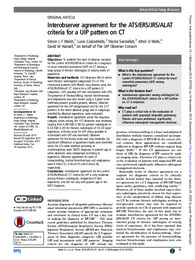Please use this identifier to cite or link to this item:
https://hdl.handle.net/11000/35264Full metadata record
| DC Field | Value | Language |
|---|---|---|
| dc.contributor.author | Walsh, Simon | - |
| dc.contributor.author | Calandriello, Lucio | - |
| dc.contributor.author | SVERZELLATI, Nicola | - |
| dc.contributor.author | Wells, Athol | - |
| dc.contributor.author | Hansell, David | - |
| dc.contributor.author | The UIP Observer Consort | - |
| dc.contributor.other | Departamentos de la UMH::Patología y Cirugía | es_ES |
| dc.date.accessioned | 2025-01-24T13:26:36Z | - |
| dc.date.available | 2025-01-24T13:26:36Z | - |
| dc.date.created | 2016 | - |
| dc.identifier.citation | Thorax. 2016 Jan;71(1):45-51 | es_ES |
| dc.identifier.issn | 1468-3296 | - |
| dc.identifier.issn | 0040-6376 | - |
| dc.identifier.uri | https://hdl.handle.net/11000/35264 | - |
| dc.description.abstract | Objectives: To establish the level of observer variation for the current ATS/ERS/JRS/ALAT criteria for a diagnosis of usual interstitial pneumonia (UIP) on CT among a large group of thoracic radiologists of varying levels of experience. Materials and methods: 112 observers (96 of whom were thoracic radiologists) categorised CTs of 150 consecutive patients with fibrotic lung disease using the ATS/ERS/JRS/ALAT CT criteria for a UIP pattern (3 categories--UIP, possibly UIP and inconsistent with UIP). The presence of honeycombing, traction bronchiectasis and emphysema was also scored using a 3-point scale (definitely present, possibly present, absent). Observer agreement for the UIP categorisation and for the 3 CT patterns in the entire observer group and in subgroups stratified by observer experience, were evaluated. Results: Interobserver agreement across the diagnosis category scores among the 112 observers was moderate, ranging from 0.48 (IQR 0.18) for general radiologists to 0.52 (IQR 0.20) for thoracic radiologists of 10-20 years' experience. A binary score for UIP versus possible or inconsistent with UIP was examined. Observer agreement for this binary score was only moderate. No significant differences in agreement levels were identified when the CTs were stratified according to multidisciplinary team (MDT) diagnosis or patient age or when observers were categorised according to experience. Observer agreement for each of honeycombing, traction bronchiectasis and emphysema were 0.59±0.12, 0.42±0.15 and 0.43±0.18, respectively. Conclusions: Interobserver agreement for the current ATS/ERS/JRS/ALAT CT criteria for UIP is only moderate among thoracic radiologists, irrespective of their experience, and did not vary with patient age or the MDT diagnosis. | es_ES |
| dc.format | application/pdf | es_ES |
| dc.format.extent | 7 | es_ES |
| dc.language.iso | eng | es_ES |
| dc.publisher | BMJ | es_ES |
| dc.rights | info:eu-repo/semantics/openAccess | es_ES |
| dc.rights | Attribution-NonCommercial-NoDerivatives 4.0 Internacional | * |
| dc.rights.uri | http://creativecommons.org/licenses/by-nc-nd/4.0/ | * |
| dc.title | Interobserver agreement for the ATS/ERS/JRS/ALAT criteria for a UIP pattern on CT | es_ES |
| dc.type | info:eu-repo/semantics/article | es_ES |
| dc.relation.publisherversion | 10.1136/thoraxjnl-2015-207252 | es_ES |

View/Open:
Interobserver agreement for the ATS-ERS-JRS-ALAT criteria for a UIP pattern on CT.pdf
1,09 MB
Adobe PDF
Share:
.png)
